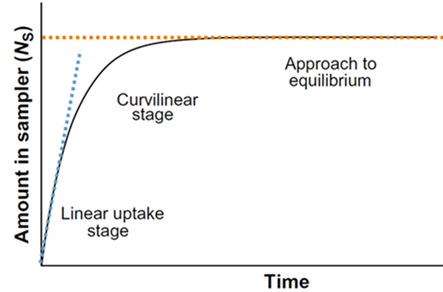Passive sampling
Passive sampling is a technique to measure chemical compounds in air. Chemicals enter the sampling material by diffusion and the sampling material is subsequently analyzed in a laboratory. This sampling method is relatively slow, so a prolonged sampling period is needed ranging from days up to months. Passive sampling can therefore only be used to measure a persons’ average exposure to the chemicals over the sampling period. However, the benefit of this type of sampler is that it is relatively small, light and should be easy to wear or place in the workplace. After the sampling is done, the chemicals are extracted from the sampler in a laboratory. The chemicals of interest are then quantified using liquid or gas chromatography. Different types of samplers are available for different types of chemicals as shown in the figure below.

Kinetic, adsorption based. Hydrophilic & volatile organic compounds (VOCs): Linear uptake ratio

Partitioning-based. Hydrophobic & semi-volatile organic compounds (sVOCs): Reaches equilibrium

E.g. TD-tube

E.g. Silicone sampler
In summary: Passive samplers can be used to measure the average concentration of a specific (s)VOC or other gaseous or vaporous hydrophilic compound. The sampling is not specific and requires prolonged sampling periods. The passive sampler can be used stationary and personal. The analysis is specific and provides an average concentration over the sampling period on a specific location when used stationary or an average exposure over the sampling period when worn in the breathing zone.
Passive sampling in the EPHOR project
Within the EPHOR project, a combined passive sampler was developed for the simultaneous measurement of semi-volatile and volatile organic compounds. Newly developed analysis methods make that these samplers can be efficiently analyzed for a wide range of different chemicals in an untargeted, screening manner. The combination of the ease of deployment, low sampling costs and large number of measured chemicals make passive sampling, as used in the EPHOR study, can be an excellent screening tool for overall exposure to chemical compounds. A video protocol on the use of this device is shown below and may be used as an example of how passive sampling is used to measure exposure to hazardous chemicals.
-
Health scientists
-
Interactive